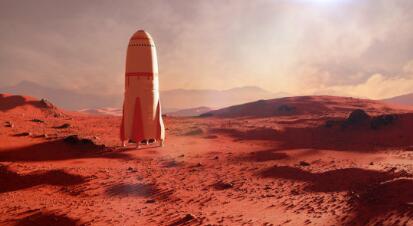Will it be safe for humans to fly to Mars?
人類飛向火星安全嗎?

credit:© dottedyeti / stock.adobe.com
Sending human travelers to Mars would require scientists and engineers to overcome a range of technological and safety obstacles. One of them is the grave risk posed by particle radiation from the sun, distant stars and galaxies.
將人類旅行者送往火星可能需要科學家和工程師們克服一系列技術和安全方面的難題。其中一個難題就是陽光、遙遠星球和銀河系所產生的粒子輻射所帶來的嚴重風險。
particle radiation:粒子輻射
Answering two key questions would go a long way toward overcoming that hurdle: Would particle radiation pose too grave a threat to human life throughout a round trip to the red planet? And, could the very timing of a mission to Mars help shield astronauts and the spacecraft from the radiation?
回答兩個關鍵問題也許對克服這一障礙大有助益:粒子輻射會對往返火星的人類生命造成嚴重威脅嗎?還有,前往火星的時機能否使宇航員和宇宙飛船免于輻射?
Spacecraft:宇宙飛船
go a long way toward:大有助益,對……有幫助
In a new article published in the peer-reviewed journal Space Weather, an international team of space scientists, including researchers from UCLA, answers those two questions with a "no" and a "yes."
在一篇發表于經過同行評審的期刊-《空間氣象》的新文章中,一個由太空科學家,包括來自于加州大學洛杉磯分校的研究人員組成的團隊用“否”和“是”對這兩個問題進行了回答。
peer-reviewed:同行評審
That is, humans should be able to safely travel to and from Mars, provided that the spacecraft has sufficient shielding and the round trip is shorter than approximately four years. And the timing of a human mission to Mars would indeed make a difference: The scientists determined that the best time for a flight to leave Earth would be when solar activity is at its peak, known as the solar maximum.
也就是說,如果宇宙飛船有足夠的防護并且往返旅行不超過大約4年的話,人類應該可以安全地往返于火星。而人類前往火星的時機確實很重要:科學家們認為離開地球,飛向火星的最佳時機應該是太陽活動性處于高峰期,也就是太陽活動極大期。
That is:就是說,即,用于解釋之前說過的內容
solar activity:太陽活動性
solar maximum:太陽活動極大期
The scientists' calculations demonstrate that it would be possible to shield a Mars-bound spacecraft from energetic particles from the sun because, during solar maximum, the most dangerous and energetic particles from distant galaxies are deflected by the enhanced solar activity.
科學家們的計算顯示,這時出發可能會使前往火星的宇宙飛船避免來自太陽的能量粒子。這是因為,在太陽活動極大期,來自遙遠星系最危險且最具能量的粒子能夠被增強的太陽活性所轉移。
Deflect:轉移、引開
A trip of that length would be conceivable. The average flight to Mars takes about nine months, so depending on the timing of launch and available fuel, it is plausible that a human mission could reach the planet and return to Earth in less than two years, according to Yuri Shprits, a UCLA research geophysicist and co-author of the paper.
特定時間的旅行是可以想象得到的。前往火星的平均飛行時間大約為9個月,因此,根據Yuri Shprits,加州大學洛杉磯分校地球物理研究者和論文的共同作者的介紹,根據發射的時間和可用的燃料,人類可以在不到2年的時間里前往火星,然后再返回地球。
"This study shows that while space radiation imposes strict limitations on how heavy the spacecraft can be and the time of launch, and it presents technological difficulties for human missions to Mars, such a mission is viable," said Shprits, who also is head of space physics and space weather at GFZ Research Centre for Geosciences in Potsdam, Germany.
“這項研究表明,盡管太陽輻射對宇宙飛船的重量和發射時間有非常嚴格的限制,而且還給人類前往火星完成任務提出了技術難題,但是任務還是可以實施的,”Shprits表示。Shprits同時也是德國波茨坦地球科學GFZ研究中心太空物理學和太空氣象部的主任。
Viable:可實施的、切實可行的
The researchers recommend a mission not longer than four years because a longer journey would expose astronauts to a dangerously high amount of radiation during the round trip -- even assuming they went when it was relatively safer than at other times. They also report that the main danger to such a flight would be particles from outside of our solar system.
研究人員建議飛行任務不超過4年,這是因為飛行時長超過4年后,會使宇航員在往返飛行時暴露在危險的、高劑量的輻射下-即使假設他們出發的時間比其他時間相對更加安全。他們還報告說,飛行的主要危險也許是來自太陽系以外的粒子。
Shprits and colleagues from UCLA, MIT, Moscow's Skolkovo Institute of Science and Technology and GFZ Potsdam combined geophysical models of particle radiation for a solar cycle with models for how radiation would affect both human passengers -- including its varying effects on different bodily organs -- and a spacecraft. The modeling determined that having a spacecraft's shell built out of a relatively thick material could help protect astronauts from radiation, but that if the shielding is too thick, it could actually increase the amount of secondary radiation to which they are exposed.
Shprits和加州大學洛杉磯分校、麻省理工學院、莫斯科斯科爾科沃科技研究所和GFZ波茨坦的同事們將太陽周期粒子輻射的地球物理模型和輻射如何影響人類乘客(包括輻射對不同人體部位所產生的不同影響)和宇宙飛船的模型相結合。通過結合模型發現,宇宙飛船的外殼采用相對較厚的材料可以幫助宇航員免于輻射,但是如果防護外殼過厚,可能會使次級輻射的量有所增加。
solar cycle:太陽周期、太陽活動周期
secondary radiation:次級輻射、二次輻射
The two main types of hazardous radiation in space are solar energetic particles and galactic cosmic rays; the intensity of each depends on solar activity. Galactic cosmic ray activity is lowest within the six to 12 months after the peak of solar activity, while solar energetic particles' intensity is greatest during solar maximum, Shprits said.
太空中的兩大有害輻射類型為太陽能粒子和銀河宇宙射線;每種輻射的強度都取決于太陽活性。銀河宇宙射線的活性在太陽火星高峰期后6-12個月內處于最低狀態,而太陽能粒子的強度則在太陽極大期處于最高峰值,Shprits表示。
來源:科學日報 翻譯&編輯:譯銳翻譯Susan

